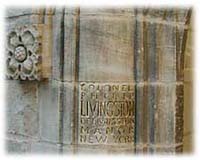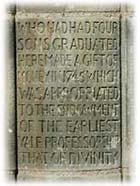Endowments
First
Professorship
First Scholarship Fund
First Library Fund
First Endowment Drive
|
The First
Endowed Professorship
Col. Philip
Livingston endowed the first professorship at Yale College. The website
of the Yale Office of Development describes
this important gift:
Philip Livingston, Second
Lord of Livingston Manor, New York, donated 28 pounds sterling to
Yale in 1745 "as a small acknowledgement of the sense I have had for
the favour and Education my sons have had there" ... The donation
was used in 1756 by President Thomas Clap to establish the Livingstonian
Professorship of Divinity, the first endowed professorship at Yale.(6)
 Col.
Philip Livingston was a slave trader. He became the Second Lord of Livingston
Manor after his father, Robert, died in 1728 (7). Robert Livingston
had made his fortune through trade, and one of his earliest investments
had been, in 1690, his purchase of "a half-interest in the Margriet,
a vessel that journeyed to Madagascar, Barbados, and Virginia to trade
in slaves, sugar, and tobacco" (8). When Robert died, Philip Livingston
inherited six of the twelve slaves listed in his father's will (9). Col.
Philip Livingston was a slave trader. He became the Second Lord of Livingston
Manor after his father, Robert, died in 1728 (7). Robert Livingston
had made his fortune through trade, and one of his earliest investments
had been, in 1690, his purchase of "a half-interest in the Margriet,
a vessel that journeyed to Madagascar, Barbados, and Virginia to trade
in slaves, sugar, and tobacco" (8). When Robert died, Philip Livingston
inherited six of the twelve slaves listed in his father's will (9).
Philip Livingston became
the heir not only of the Manor, but also of the family business:
The importation of slaves
was an attractive sideline to Robert's son Philip and grandson Robert,
Jr. Philip was a leading importer of slaves from Jamaica and Antigua
during the 1730s. He was part owner of a number of vessels, some of
which were owned in partnership with his sons ... In August 1733,
Philip's sloop Katherine brought in fifty blacks from Jamaica, an
unusually large shipment from that source. (10)
Philip's extensive trade
with the West Indies led to his involvement in the African slave trade.
In the 1730s and 1740s, he was one of New York's leading importers
of slave labor from the sugar islands, and also one of few New Yorkers
who imported slaves directly from Africa before the abolition of the
Spanish Asiento in 1748. In 1738, Philip bought a one-third share
in a voyage to Guinea, where two hundred slaves were purchased and
consigned to his son Peter Van Brugh Livingston and his partner in
Jamaica. New York's direct trade with Africa grew significantly after
1748, and the Livingstons continued to be among the colony's leading
Africa traders. (11)
Philip Livingston was one
of New York's most prominent slave traders:
Only two men, Nathaniel
Marston and Philip Livingston, invested in as many as four slave ships
... Philip Livingston was a large importer from West Indian sources
in the 1730s and 1740s, and after King George's War joined with his
sons to invest in four African slavers ... Livingston, third ranking
importer in the NORNY records, brought in 219 West Indian blacks.
With his sons he owned shares in the slavers Wolf, Rhode Island, Stork,
and Sarah and Elizabeth during the early 1750s. (12)
 A
letter from one of Philip Livingston's sons to Petrus DeWitt, a merchant
on the Livingston Manor, describes one of these voyages: "We have, thank
God, had the good fortune of having one of our Guinea sloops come in,
tho after a long passage of 79 days in which time they bumped 37 slaves
and since 3 more & 2 more likely to die, which is an accident not to
be helped ... We have now about 80 well slaves, 44 ounces of Gold &
goods of Elephant's tooth ...." (13) A
letter from one of Philip Livingston's sons to Petrus DeWitt, a merchant
on the Livingston Manor, describes one of these voyages: "We have, thank
God, had the good fortune of having one of our Guinea sloops come in,
tho after a long passage of 79 days in which time they bumped 37 slaves
and since 3 more & 2 more likely to die, which is an accident not to
be helped ... We have now about 80 well slaves, 44 ounces of Gold &
goods of Elephant's tooth ...." (13)
Philip Livingston's generous
donation to Yale College occurred at the height of his involvement in
the slave trade. Hence, profits from the slave trade funded the endowment
of Yale's first professorship. In addition to naming the first endowed
professor's chair after Livingston, Yale also named a prominent gateway
in Branford College the "Livingston
Gateway."
|
Numbers in parentheses refer
to notes. See the notes page.
|

 Col.
Philip Livingston was a slave trader. He became the Second Lord of Livingston
Manor after his father, Robert, died in 1728 (7). Robert Livingston
had made his fortune through trade, and one of his earliest investments
had been, in 1690, his purchase of "a half-interest in the Margriet,
a vessel that journeyed to Madagascar, Barbados, and Virginia to trade
in slaves, sugar, and tobacco" (8). When Robert died, Philip Livingston
inherited six of the twelve slaves listed in his father's will (9).
Col.
Philip Livingston was a slave trader. He became the Second Lord of Livingston
Manor after his father, Robert, died in 1728 (7). Robert Livingston
had made his fortune through trade, and one of his earliest investments
had been, in 1690, his purchase of "a half-interest in the Margriet,
a vessel that journeyed to Madagascar, Barbados, and Virginia to trade
in slaves, sugar, and tobacco" (8). When Robert died, Philip Livingston
inherited six of the twelve slaves listed in his father's will (9). A
letter from one of Philip Livingston's sons to Petrus DeWitt, a merchant
on the Livingston Manor, describes one of these voyages: "We have, thank
God, had the good fortune of having one of our Guinea sloops come in,
tho after a long passage of 79 days in which time they bumped 37 slaves
and since 3 more & 2 more likely to die, which is an accident not to
be helped ... We have now about 80 well slaves, 44 ounces of Gold &
goods of Elephant's tooth ...." (13)
A
letter from one of Philip Livingston's sons to Petrus DeWitt, a merchant
on the Livingston Manor, describes one of these voyages: "We have, thank
God, had the good fortune of having one of our Guinea sloops come in,
tho after a long passage of 79 days in which time they bumped 37 slaves
and since 3 more & 2 more likely to die, which is an accident not to
be helped ... We have now about 80 well slaves, 44 ounces of Gold &
goods of Elephant's tooth ...." (13)